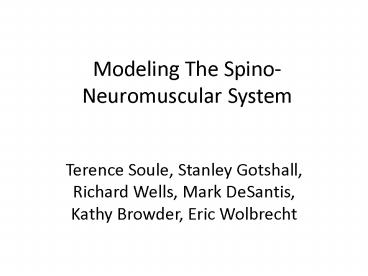Modeling The SpinoNeuromuscular System - PowerPoint PPT Presentation
Title:
Modeling The SpinoNeuromuscular System
Description:
Build a biologically accurate model of (a small piece of) the ... Biceps' applied. force. Triceps. equivalent. Triceps' applied. force. Neural Model High Level ... – PowerPoint PPT presentation
Number of Views:39
Avg rating:3.0/5.0
Title: Modeling The SpinoNeuromuscular System
1
Modeling The Spino-Neuromuscular System
- Terence Soule, Stanley Gotshall, Richard Wells,
Mark DeSantis, Kathy Browder, Eric Wolbrecht
2
Goals/Motivation
- Build a biologically accurate model of (a small
piece of) the spino-neuromuscular system - Biological modeling
- Hypothesis Testing
- Injury modeling
- Better Robots
3
Physical Model
Triceps equivalent
Biceps equivalent
Triceps applied force
Biceps applied force
q
Gravitational force
4
Neural Model High Level
Renshaw Inhibition
Muscle Fibers (6 per muscle)
I
User controlled input
Neural Networks (12 total)
5
Neural Model Detailed
52 Synaptic Connections x 6 Motor Units Per
Muscle x 2 Muscles 624 Synapses!
6
Some Feedback Loops
Intrafusal Fibers
Renshaw Cell
Extrafusal Fibers
Alpha-MN
Gamma MN
7
Neurons
- Neurons are pulse coded
Neuron Fires
Threshold
Neuron Potential
Time
Input Signals
Refractory period
8
Goal Desired Behavior
9
Inputs??
- What input do you use to tell the arm to move up?
Down? Move fast? Hold still? - Encoding problem
- Arbitrary solution
- Up -gt high frequency input 60 Hertz
- Down -gt lower frequency input 30 Hertz
10
Problem
- Anatomy/network is known
- Reflex pathways
- Neuron types
- Inhibitory/excitatory connections
- Strength of connections is unknown
11
Representation of Connections
Array of connection strengths muscle fiber
strengths 0.23 1.43 2.3 0.21 631
Total Values Need to find a set of values that
allows the model to behave properly. Inter-relat
ion between values is very complex, i.e.
non-linear.
12
Evolutionary Training
- Need to adjust the strengths of inter-neuron
connections muscle fiber strengths
(potential) solutions w/ fitnesses
Population
New Population
13
Fitness
- Root mean squared error
- Square root of the sum of the squared errors
between actual and target motion at a series of
points along the desired trajectory.
14
Crossover and Mutation
0.23 1.43 2.3 0.32 1.3 0.21 0.43
0.14 2.3 1.67 1.5 1.32 0.23 1.43
2.3 1.67 1.3 1.32 0.43 0.19 2.3
0.32 1.5 0.21
Crossover
New solutions (offspring) based on parent
solutions.
Mutation
15
Results - Behavior
16
Results - Training
17
Co-activation, Tonic Tension
18
Recruitment
19
Results ? motor neuron
20
StabilityAltering weight
21
StabilityAltering arm weight
0.65kg approaches the peak faster than 0.55kg
22
Results - Generalizability
Training on multiple cases improves behavior on
out of sample test cases.
23
StabilityAltering speeds/frequencies
24
StabilityAltering speeds/frequencies
25
Training Algorithms
26
Conclusions
- Model is trainable
- Trainable with mixed variable types (connection
strengths and muscle fiber strengths) - Model produces fundamental biological behaviors
- Increasing complexity produced better behavior
- Model is robust, proper training helps
27
Future Work
- Train more complex behaviors
- Generalized movement
- Adaptation to injury
- Real robots ( w/simpler networks and neurons)
- Non-pulse coded neurons
- One fiber/actuator per muscle
- Simpler networks
- Known angles































